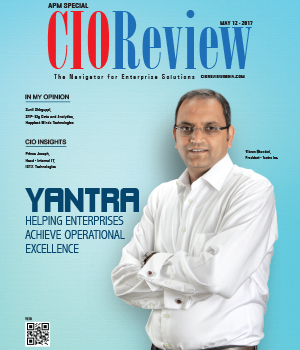
Modernization of Applications through APM Solutions
Sunil Shirguppi, SVP- Big Data and Analytics, Happiest Minds Technologies | Tuesday, 23 May 2017, 11:40 IST
 Apps are currently ruling the digital world. The advent of applications has redefined the way people do business and simplified many complex business processes. This widespread usage and reach of applications has made the business environment more competitive than ever before. In this age of digital transformation, the success of any business is closely knitted with the performance of the applications that they possess. With a deluge of applications being used by businesses internally and externally, monitoring and managing their performance has become pivotal for technology teams so that they can take quick preventive actions against application performance issues and failures. It’s safe to say that application performance has a direct correlation to customer loyalty and it is imperative that the application support teams quickly detect the root cause and provide a fix. What is Application Performance Management (APM) APM is the monitoring and management of software applications to provide a high level of user experience. The primary goal of APM systems is to identify normal behaviors of the applications and eventually alert application owners in instances of deviation from the normal behaviors. The end goal is to keep applications healthy and eventually provide a positive user experience.
Apps are currently ruling the digital world. The advent of applications has redefined the way people do business and simplified many complex business processes. This widespread usage and reach of applications has made the business environment more competitive than ever before. In this age of digital transformation, the success of any business is closely knitted with the performance of the applications that they possess. With a deluge of applications being used by businesses internally and externally, monitoring and managing their performance has become pivotal for technology teams so that they can take quick preventive actions against application performance issues and failures. It’s safe to say that application performance has a direct correlation to customer loyalty and it is imperative that the application support teams quickly detect the root cause and provide a fix. What is Application Performance Management (APM) APM is the monitoring and management of software applications to provide a high level of user experience. The primary goal of APM systems is to identify normal behaviors of the applications and eventually alert application owners in instances of deviation from the normal behaviors. The end goal is to keep applications healthy and eventually provide a positive user experience.
Current landscape
Creating and maintaining an all-inclusive APM strategy is highly significant for any organization in this digital age. For businesses that look for customer engagement and brand loyalty, if they fail to provide an outstanding user experience in their applications, it often leads to abandoned carts, loss of revenue and reputation. To avoid this, businesses are considering proactive and intelligent APM as a top priority. However, with the advent of disruptive technologies including cloud with its variations of private, public, hybrid and mobility, it has become ever more challenging to monitor and manage business applications
As per Gartner, the five functional dimensions that are required for achieving ROI from APM are:
1. Monitoring user experience: This involves capturing data regarding the end to end availability of applications, logical execution steps, latencies if any, overall quality of the applications experienced by the user.
2. Identification and visualization of run time application architecture: This covers the identification of the diverse software and hardware components involved in the execution and visualization of possible paths that these components would interact and involve.
3. User defined profiling of application transactions: Tracing the events as they occur among the various components involved.
4. In-depth monitoring of components: This involves an in-depth monitoring of the resources consumed by the application and the events occurring within the components.
5. Deriving meaningful insights through analytics: This includes implementation of analytics techniques including behavior learning engines, complex-event processing (CEP) platforms, log analysis and multidimensional database analysis to discover the valuable and hidden insights from the data chunks collected.
Besides all these highly defined objectives and dimensions to achieve those, Enterprises as well as startups face the classic dilemma of “Build vs. Buy” when it comes to implementing APM. While on one hand it looks like a no brainer to build an APM solution in house, there are multiple challenges in building a fully functional APM solution.
Some of the key challenges faced by businesses in building their own APM solutions include –
1. Data Collection: APM solutions need telemetry data both from a standpoint of infrastructure as well as applications. However, application and infrastructure owners typically treat telemetry collection as an afterthought.
2. Application dependency discovery: As organizations grow, they also tend to onboard numerous applications, processes on varied infra stacks. This results in an ecosystem that becomes heterogeneous in nature. However, organizations don’t do a great job in identifying and documenting dependency between all parts of the ecosystem.
Role of Analytics in APM
With advancements in open source stacks and learning models, companies are building predictive models that can warn application and infrastructure owners of problems that are about to happen in the near future. Now, there are models being built that can even predict if a hard drive has a certain probability of failing or storage space getting filled, way before it affects the customer. Analytics models can also pinpoint the exact cause of failures so they can be remediated in a faster manner.
Trends and Outlook
APM has been in news recently due to acquisition of AppDynamics by Cisco. By acquiring Appdynamics, companies like Cisco can now get end to end visibility all the way from their data centers to the individual applications that are interfacing with end users.
As digital transformation and customer engagement are becoming more important, APM market is set to grow at a healthy pace in the coming years. According to Gartner, the growing number of parties who have a stake in APM, including application development teams and business executives is gaining significant traction. Coupled with increase in fragmentation and modularization of infrastructure, companies now need mature platforms that can monitor and maintain their infra and application stacks in a much more efficient manner.
CIO Viewpoint
Focus of Application Management Solution...
By Martin Ingram, SVP & CIO, Arise Virtual Solutions Inc.
Need of the Hour: Customer Centric Build-Up of...
By Warren Neuburger, CIO & EVP Global Operations & Customer Care, PGi
Sustaining Performance and User Experience...
By Amit Pal Singh, Head - IT Transformation, Gionee India
CXO Insights
Modernizing a Company's Digital Core is Vital...
By Randy Meyer, VP & General Manager, Hewlett Packard Enterprise
5 Key Take a ways for Successful ALM...







